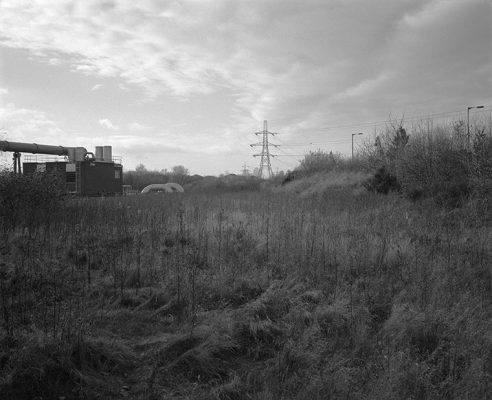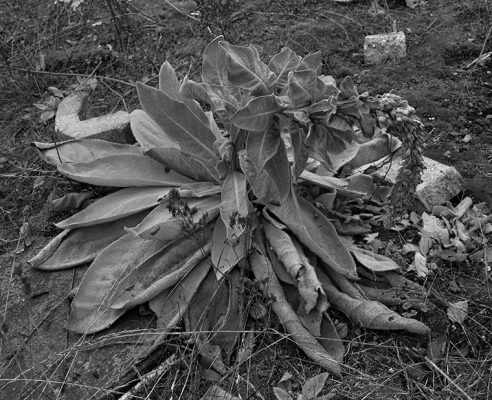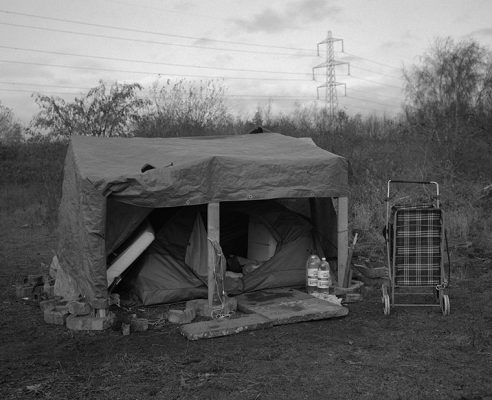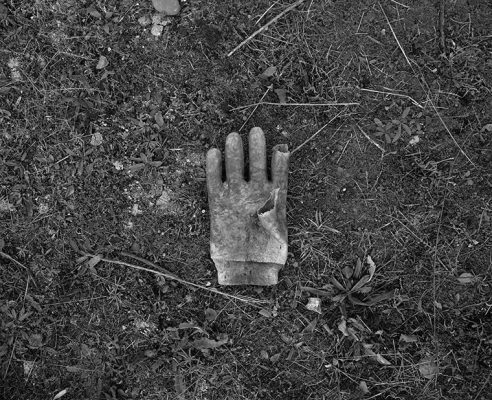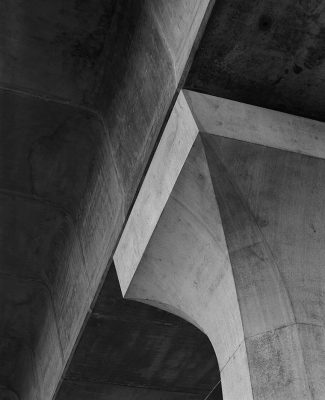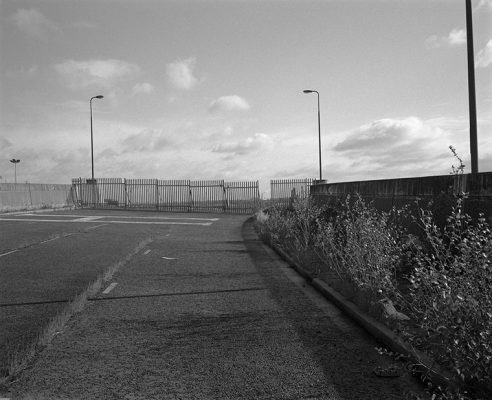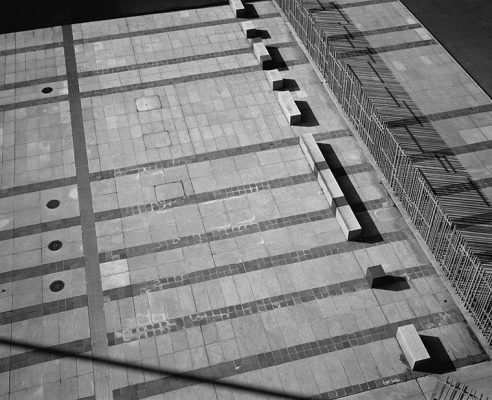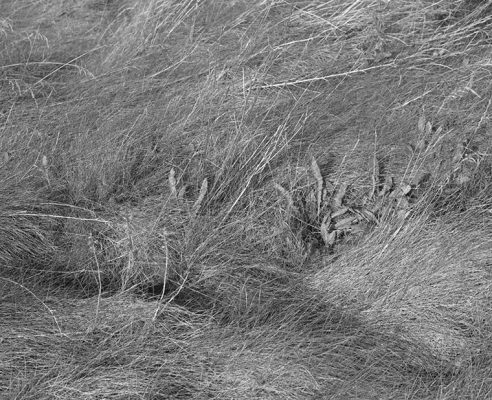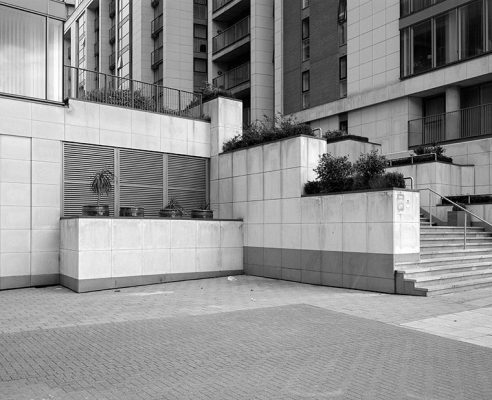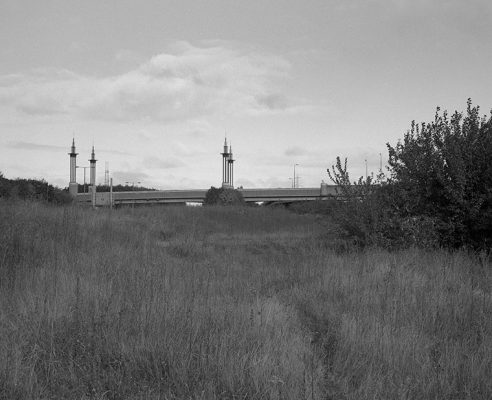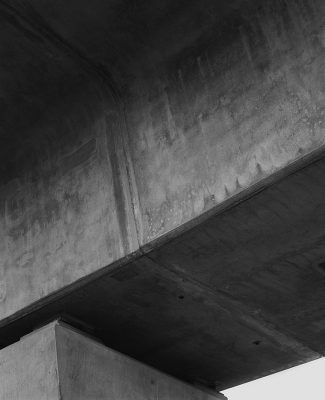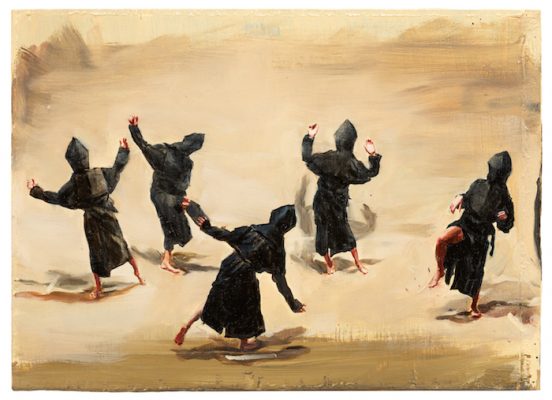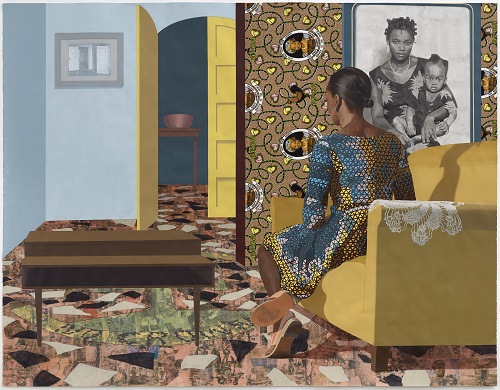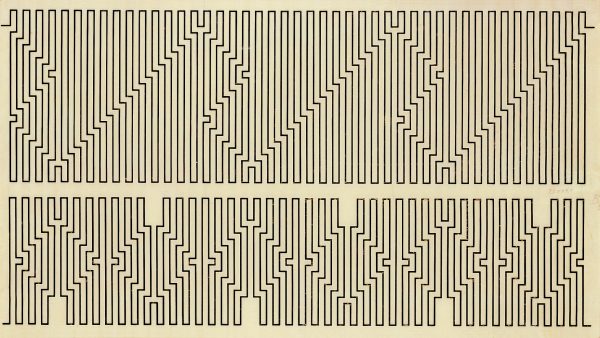I am standing in a parallelogram of shrubbery outside London City Airport. Ed is twisting a dial on his Mamiya RZ67 and squinting into its viewfinder. He is wearing a Berghaus anorak, as standard, with a beanie hat, hiking boots and a flannel shirt. His breath is clouding up around his face.
The camera’s lens is pointing at a factory in the distance, a complex heap of blocks and towers known locally as Sugar Mountain, officially as Tate & Lyle. It rises abruptly at the end of the residential street, a gargantuan prison-like structure that might have functioned as a set for the film adaptation of 1984 had they not used the ruinous Beckton Gas Works a few miles east of here. It is an architecturally hermetic building, anxious to preserve the final vestige of industrial productivity in an otherwise idle landscape. Directly in front of us is a two-lane arterial road. Cars zip past like urgent telegrams. Every surface has been designed to enclose, repel or separate. There are wooden fences embedded in concrete troughs. There are concrete bridges and glass walls. There are barriers, railings and painted lines—
‘Excuse me? You’re not allowed to take pictures here!’
We turn to see a man in a hi-vis vest. His nylon shirt is of that municipal noncolour that sits somewhere between turquoise and grey. An ID card hangs from a branded lanyard at his neck.
The best thing to do in situations like these is ignore the non-threats, take the photograph you’ve come to take and defend that tiny patch of civil freedom from the powers that seek to invade. The official seems reluctant to break the invisible screen that separates the designated walking space from the decorative shrubs in which we stand. It isn’t long before he strides forth, stepping through the plants in standard-issue boots, to reiterate his demands.
*
Consciously structured to minimise friction, slowness and delay, airports are places of social and spatial control. Their architecture tends towards the abstraction of geometry, lines, lanes, parabolas and arcs; grids across which the traveller moves like a mathematical function. Passengers are screened and processed: those who fail to meet standards are incarcerated or rebuffed, and the rest are funnelled through the airport’s branching architecture and up into the sky.
Rather than inhabiting a particular point in space, with all its social, geographical and historical specificity, it feels as though we’re caught in an intersection of extended lines: flows that move from Lisbon to London to Luxembourg, from Beckton to Canning Town. Most of the people who use this airport are business class human beings. There’s an abundance of men and women in suits, pinstripe and plain, tugging those tiny one-night travel bags with the plastic wheels and the telescopic handles, with broadsheets tucked beneath their arms. The workers who comprise the airport’s staff are differently choreographed, slower and more intimately linked to their surroundings. They empty bins, fix broken light fittings and direct baffled passengers towards the lavishly signposted check-in desks. Two policemen sit outside the entrance in an unmarked 4×4, peering through the windshield as they slurp their paper cups of post-mix Diet Coke. Pale clouds above, pallid concrete below. It is cold, not yet the brutal X-ray cold of the coming winter, but a crisp and vivid chill that pulls all edges into focus.
*
‘It’s actually illegal what you’re doing. If you don’t stop taking pictures I’m going to have to involve the police. I don’t want to have to do that, you know, I don’t want to, but I will, because you’re not allowed to take pictures here, it’s as simple as that.’ And so on.
The Mamiya RZ67 is a medium format camera. It’s roughly a foot long and distinctly unwieldy, with its bellows-mounted lens and periscope viewfinder. You don’t carry so much as lug it around, like a bag of bricks or a sleeping child. Add the fact that the camera is generally used with a tripod, and the result is among the most conspicuous ‘I AM A CAMERA!’-style cameras in the game. It’s unlikely we’re doing anything suspicious. If we were, we’d be using iPhones.
We aren’t living through this moment so much as playing our part in a choreographed scene, a diorama of urban trespass. What’s doubly absurd about the situation is that the photograph just taken is, admittedly, boring. Once Ed has developed the film in his bathtub a few days from now, this black-and-white landscape will faithfully convey the sprawling blandness of the scene, its generically urban bleakness. Photographers are not a common sight around these parts, which might partly explain the disproportionate paranoia. What puzzles me is the demonstrable fact that we aren’t interested in the airport itself: the lens is pointing the other way, and so is our attention. The official continually threatens to call the police but the theft, if that is what this is, has already taken place. Ed pulls the image into focus and clicks the trigger: light enters the chamber and exposes the film.
We walk off, nipping through gaps in the passing cars, and the official watches us leave. The way the sun slopes in at a mid-October angle, barely high enough to scrape the tops of the local factories, makes the airport glow like a pyre.
***
Silvertown in London’s Docklands, east of the Isle of Dogs, west of Beckton and north of the Millennium Dome, is custom built for post-apocalyptic fantasies. It’s the kind of landscape you’d glimpse through a train window and quickly forget, a featureless portal to other, more interesting places. It is the antithesis of spectacular London; of skyscrapers named after kitchen utensils; of the Olympics. Once a busy stretch of smokestacks, mills and quays, Silvertown feels today like the site of a mass evacuation. (During the Blitz, it was precisely that.) It came into being almost overnight, in a flurry of industrial speculation during the mid-nineteenth century, and collapsed a little over a century later. The haste of its construction matched the speed with which it was later abandoned. Silvertown is a synecdoche of post-industrial Britain. It came from humble origins, ascended an apex of power and pride, then fortune struck it low and now it languishes in obsolescence, waiting to be digested by the future that consumed it.
*
In 1844, Silvertown did not exist. Seven feet below the water level, these acres of marsh were dotted with patches of quicksand and sunk in floodwater each spring. Cattle grazed, reeds grew, Viking, Dane, Saxon and Roman relics slowly petrified in alluvial mud, but hardly anything settled here – why would it? This is how London looked before London existed: a wet and windswept fenland, its soft topology contoured by the creep and suck of tidal fluid.
The River Lea marks the border between London and Essex – although, as Dickens opined, ‘there is no limit to London’ – and thus the area fell outside the capital’s municipal purview. This hinterland status had been with it for centuries. During the 1300s the Sherriff of Kent renamed the area Wicklands, ‘Between-Lands’. And it might have stayed like that, an overlooked stretch of empty, sunken marsh, were it not for the Metropolitan Buildings Act, newly introduced in 1844, which banished harmful industries like animal rendering, printing, and chemical manufacture from the capital.
Enter the historical personage of Samuel Silver. By all accounts, of which there are few, he was an archetypal Victorian tycoon. Driven from the capital by the Act, he set his eye on a muddy stretch of river. In 1852, he opened a rubber factory which produced waterproof clothing, belts for machinery, telegraph cables and ebonite, a form of vulcanised rubber. Silver’s factory was the only building for miles; but factories create jobs, and jobs attract people, and soon the building began to send out feelers, terraced tenements where workers lived within spitting distance of their jobs. A shipbuilders and ironworks sprang up on nearby land; soon two sugar moguls, Mr Tate and Mr Lyle, established factories here too. Reed-green was steadily smothered by concrete-grey. The industrial outposts started to link and mesh as roads and housing grew, like isolated cells expanding and connecting into a tissue, hardening the land to industrial use. This stretch of the Plaistow Marshes, once a blank on a map, is named in honour of its founder: Silver’s Town.
*
A trio of interlinked water trenches forms the hollow core around which Silvertown is oriented. Built between 1855 and 1921, the Royal Docks were the largest in the world, deep enough to accommodate the hulking steam ships that hove in, pregnant with wares, from British colonies in Africa, India and the Middle East. These massive ships weighed around 30,000 tonnes – which goes some way to explain the vast scale of the docks, and the weight of mourning their abandonment implies – and linked the city to other merchant cities around the globe.
What happened next is typical, not just of the Docklands, but of all commercial ports. From the 1950s onwards containerised shipping became increasingly common and the docks weren’t able to service the much larger ships, nor were they designed to handle the new standardised steel containers. The docks at Tilbury in Essex took up the slack, and Silvertown’s quaysides steadily emptied. Thousands of jobs, most of which were casual, poorly paid and in constantly short supply, were lost; dock companies folded, warehouses shut down and the local communities dissipated.
Since then, not much has changed. Silvertown is ripe for redevelopment, but such alchemical transformation has yet to take place. Decommissioned factories, apartment complexes, building sites, waste grounds and public parks are thrown together without purpose or plan, a midden of industrial off-cuts and reject space. Canary Wharf was redeveloped and so was Beckton, but Silvertown has yet to be invaded and transformed.
